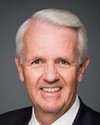Mr. Speaker, I am pleased to rise today in the foreshortened debate on Bill C-49. After only one hour of debate, the Conservatives decided it was time to shorten the debate even further by imposing time allocation.
The minister referred to this legislation as having been on the books for eight and a half months. We are not in control of the agenda; the other side is in control of the agenda. If it chose not to bring it forward over the past eight and a half months, that is not our fault. The minister might want to speak to the government House leader to find out why it has taken so long for the bill to come forward.
Members opposite keep saying that we are creating a museum. This bill would not create a museum. It would destroy one museum and out of its ashes build another. It is a good idea. We on this side think a Canadian historical museum would be a good thing to have, but we should not destroy the Canadian Museum of Civilization, which has an entirely different mandate and an entirely different purpose than a Canadian museum of history.
The mandate of the Canadian Museum of Civilization is:
—to increase, throughout Canada and internationally, interest in, knowledge and critical understanding of and appreciation and respect for human cultural achievements and human behavior by establishing, maintaining and developing for research and posterity a collection of objects of historical or cultural interest, with special but not exclusive reference to Canada, and by demonstrating those achievements and behaviour, the knowledge derived from them and the understanding they represent.
This is a very broad and ambitious goal and the museum has met some of that goal over the course of the past 23 years that it has been in existence.
I have been there. It is an absolutely amazing place. What it puts forward is way more than just history. It is in fact about the culture and civilization of not just Canada, but of many places in the world, and of Canada not just the country, but Canada as it existed before the white man arrived. This is also in that existing human cultural achievements.
The new mandate of the Canadian history museum is
—to enhance Canadians’ knowledge, understanding and appreciation of events, experiences, people and objects that reflect and have shaped Canada’s history and identity, and also to enhance their awareness of world history and cultures.
I emphasize the word “Canada's” history and identity because we now lose the notion of civilization. Canada did not exist officially until 1867. Does this mean we are only to discuss things that happened from 1867 forward, that the contributions of the fact that this continent was peopled by native North Americans long before any of us Europeans ever arrived on the scene? Is that not to be considered as part of Canada's history? It is hard to tell from the statement of mandate of what the intention of this history is.
We have in the Canadian Museum of Civilization an internationally regarded icon of something more than just history, and it is associated with the war museum. In France, there is no museum of war. There is a museum of peace and it too is internationally regarded as a place to discuss something other than historical artifacts leading to war, or historical art leading to war or whatever wants to be discussed. That notion of discussing peace lends itself to an international recognition. The notion of discussing civilization lends us to an international recognition, which I fear we will lose by focusing on only history and only the history of Canada.
In terms of the amendments that were proposed by the various bodies in the foreshortened again committee stage, one of the ones that the minister referred to earlier, was the suggestion that there should be curatorial independence. Curatorial independence means that the museum, whether it is the Museum of Civilization or the museum of history, should be in a position to decide itself what it wants to display, how it wants to display it and whether it should take on controversial displays.
The minister said today in the House, “As the minister, I have never once, nor could I ever interfere with the decision of a museum to put on an exhibit or not”. When he said that, I could not believe my ears, because it was just a few short months ago that an Ottawa museum, the Museum of Science and Technology, put on an exhibit that the minister said, “The exhibit does not fit within its mandate. Its content cannot be defended and is insulting to taxpayers”.
The minister will stand and argue that he did not actually tell the museum not to run it. When a minister gets up and publicly states that something is not within its mandate and is insulting to taxpayers, he is questioning the curatorial independence of that museum. To stand here in the House today and suggest he has never done it is beggars belief.
When the museum put on that display, it was clearly going to be controversial, a display that the museum itself and its curators decided was important and within its mandate, but the minister interfered.
Is that making a statement publicly that something is not within its mandate and is insulting to taxpayers somehow not interfering in the mandate of the museum or in the ability of the museum's curators to have curatorial independence? In my view it does. Whether the minister actually pulled the display off the shelves with his own hands is not really the question. The question is whether the minister publicly went against the decision of the museum itself. That is what we, on this side of the House, want to see more strongly placed in legislation as we get the opportunity because of the events of the past year.
The third point I will make is the concerns we have about creating a museum of history at the same time the government has gone about rewriting history. For example, even today, when the minister said that he never did that, yet he did a year ago, is rewriting history. It is suggesting that it did not actually happen.
However, we are concerned we have a government that wants Canadians to be more focused on battles, on wars, on the War of 1812, on the relationship with the British Crown, on the battles that Canada has been in since Confederation and maybe a little before, because we have been talking about the War of 1812.
Twitter uses hashtags to get people interested in a topic, and the hashtag is, “HarperHistory”. That hashtag was created because the Prime Minister started to rewrite history in the House of Commons in question period by making erroneous allegations about the NDP. That hashtag, “HarperHistory” resurfaced again in the past few weeks when the Standing Committee on Canadian Heritage decided to undertake a thorough and comprehensive review of significant aspects of Canadian history.
There was a breakdown, a comparison of relevant standards of courses of study offered in primary and post-secondary institutions and there were considerable numbers of people responding to the hashtag “HarperHistory” who were—







